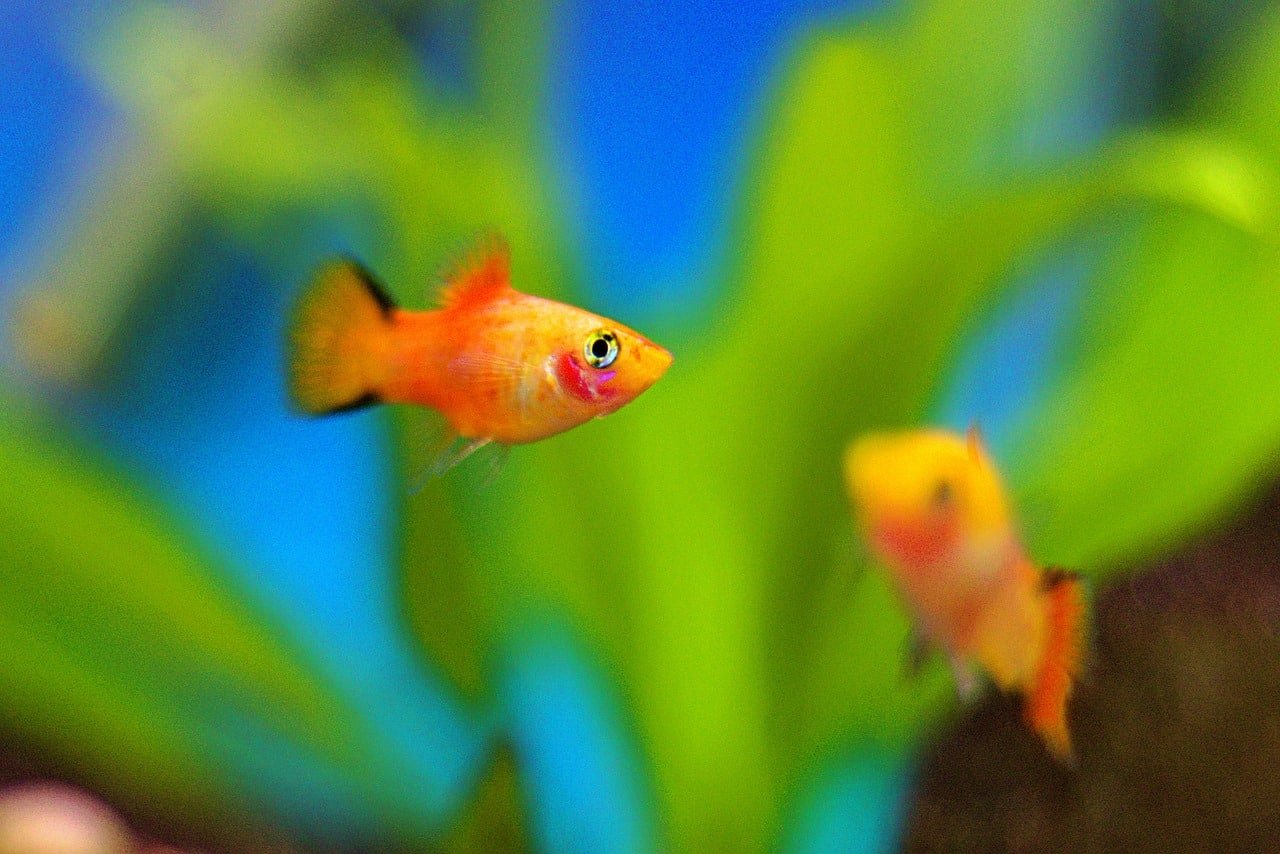The Blue Mickey Mouse Platy is a stunning and delightful addition to any aquarium. Named for its striking blue coloration and the distinctive Mickey Mouse-shaped markings near its tail, this fish is a favorite among aquarists. This comprehensive guide will cover everything you need to know about Blue Mickey Mouse Platies, from their care and breeding to common health issues and tank setup.
Introduction to Blue Mickey Mouse Platy
The Blue Mickey Mouse Platy (Xiphophorus maculatus) is a small freshwater fish native to Central America. It belongs to the Poeciliidae family, which includes other popular aquarium species like guppies and mollies. This platy is particularly noted for its vibrant blue color and the unique black marking near its tail that resembles the iconic Mickey Mouse silhouette. As livebearers, Blue Mickey Mouse Platies give birth to live young rather than laying eggs, making them fascinating to observe.

Types of Blue Mickey Mouse Platy
Blue Mickey Mouse Platies can vary in color intensity and patterns, offering a range of beautiful options for your aquarium.
1. Deep Blue Mickey Mouse Platy
This type features a deep, rich blue coloration that is uniform across the body. The contrast between the blue body and the black Mickey Mouse marking near the tail is striking and adds a dramatic flair to the aquarium.
2. Sky Blue Mickey Mouse Platy
Sky Blue Mickey Mouse Platies have a lighter, more pastel blue hue. This soft blue color provides a serene and calming appearance, making these platies a peaceful addition to any tank.
3. Blue and Black Mickey Mouse Platy
This variant exhibits a mix of blue shades with black marbling patterns. The marbling creates interesting and unique designs, adding an extra layer of visual interest to your aquarium.
Care Requirements for Blue Mickey Mouse Platy
Blue Mickey Mouse Platies are relatively easy to care for, making them an excellent choice for both novice and experienced aquarists. Here are the key aspects of their care:
1. Tank Setup
- Tank Size: A minimum of 10 gallons is recommended for a small group of platies. Larger tanks are better as they provide more stable water conditions and ample space for the fish to swim.
- Water Conditions: Platies thrive in slightly alkaline water with a pH between 7.0 and 8.2. The ideal water temperature is between 70°F and 78°F (21°C to 26°C).
- Filtration: A reliable filtration system is essential to maintain water quality. Regular water changes of 25-30% every two weeks are also necessary to keep the environment clean.
- Decorations: Provide plenty of hiding spots and vegetation. Live or artificial plants, rocks, and driftwood can create a comfortable and stimulating environment for your fish.
2. Diet
Blue Mickey Mouse Platies are omnivores and enjoy a varied diet. To keep them healthy and vibrant, provide a balanced diet that includes:
- Flake Food: High-quality flake food should be the staple of their diet.
- Frozen or Live Food: Supplement their diet with frozen or live foods such as brine shrimp, daphnia, and bloodworms.
- Vegetables: Blanched vegetables like spinach, zucchini, and peas can provide essential nutrients and variety.
3. Behavior and Tank Mates
Blue Mickey Mouse Platies are peaceful and social fish that do well in community tanks. They are active swimmers and enjoy exploring their environment. Suitable tank mates for Blue Mickey Mouse Platies include:
- Other livebearers like guppies and mollies.
- Peaceful species like tetras, danios, and corydoras.
- Avoid aggressive or fin-nipping fish that may harm the platies.
4. Breeding Blue Mickey Mouse Platy
Breeding Blue Mickey Mouse Platies is relatively straightforward, and they often breed without any intervention from the aquarist. Here are some tips for successful breeding:
- Separate Breeding Tank: If you want to breed platies, consider setting up a separate breeding tank to protect the fry from being eaten by adult fish.
- Pregnant Females: Female Blue Mickey Mouse Platies give birth to live young every 4-6 weeks, producing 20-40 fry at a time. Look for a rounded abdomen and a dark gravid spot near the anal fin to identify pregnant females.
- Feeding Fry: Once the fry are born, provide them with finely crushed flake food or specialized fry food. Ensure the tank has plenty of hiding spots for the fry to avoid predation.
5. Common Health Issues and How to Prevent Them
Blue Mickey Mouse Platies are generally hardy fish, but they can still be susceptible to certain health issues. Understanding these common problems and how to prevent them is crucial for maintaining a healthy aquarium.
1. Ich (White Spot Disease)
Ich is a common parasitic infection that presents as white spots on the fish’s body and fins. It can cause irritation, rubbing, and lethargy.
- Prevention: Maintain good water quality and avoid sudden temperature changes. Quarantine new fish before introducing them to the main tank.
- Treatment: Increase the water temperature gradually to 86°F (30°C) and treat with ich medication as per the manufacturer’s instructions.
2. Fin Rot
Fin rot is a bacterial infection that causes the fins to become ragged and discolored. It is often a result of poor water quality or injury.
- Prevention: Keep the tank clean and perform regular water changes. Avoid overstocking and reduce stress by providing hiding places.
- Treatment: Use antibacterial medication and improve water quality. Isolate affected fish to prevent the spread of infection.
3. Swim Bladder Disorder
Swim bladder disorder affects the fish’s buoyancy, causing them to float at the surface or sink to the bottom.
- Prevention: Avoid overfeeding and provide a balanced diet. Soak dry foods before feeding to prevent them from expanding in the fish’s stomach.
- Treatment: Fast the fish for 24-48 hours and then feed them a cooked, peeled pea to help clear any blockages.
6. Tips for a Healthy Aquarium
Maintaining a healthy environment for your Blue Mickey Mouse Platies is crucial for their well-being. Here are some additional tips:
- Regular Monitoring: Keep an eye on water parameters such as pH, temperature, ammonia, nitrite, and nitrate levels. Regular testing will help you catch and correct any imbalances early.
- Tank Maintenance: Clean the tank regularly by removing uneaten food, detritus, and algae. Perform partial water changes to keep the water clean and clear.
- Avoid Overcrowding: Overcrowding can lead to stress, aggression, and poor water quality. Make sure you provide enough space for each fish to swim and hide comfortably.
- Provide Enrichment: Platies are curious and active fish. Adding plants, decorations, and changing the tank layout occasionally can keep them stimulated and reduce stress.
7. Breeding Behavior and Fry Care
Blue Mickey Mouse Platies are prolific breeders and often reproduce without much intervention from the aquarist. To ensure the best chances for the fry, consider these tips:
- Identifying Pregnant Females: Female platies develop a rounded abdomen and a dark gravid spot near the anal fin when they are pregnant. This spot is where the fry are developing.
- Setting Up a Breeding Tank: A separate breeding tank or a breeding box within the main tank can protect the fry from being eaten by adult fish. Include plenty of hiding spots with plants and decorations.
- Caring for Fry: Once the fry are born, they need small, frequent feedings. Crushed flake food, baby brine shrimp, and specially formulated fry food are ideal. Ensure good water quality by performing regular water changes.
8. Understanding Platy Behavior
Observing and understanding the behavior of your Blue Mickey Mouse Platies can help you ensure they are healthy and happy.
- Social Structure: Platies are social fish and thrive in groups. A ratio of one male to two or three females can help reduce stress and prevent males from constantly chasing females.
- Active Swimmers: Platies are active swimmers and enjoy exploring their environment. Providing plenty of space and a stimulating environment with plants and decorations can keep them happy.
- Peaceful Nature: Platies are peaceful fish and do well with other non-aggressive species. Avoid housing them with larger, aggressive fish that may bully or eat them.
9. Common Myths About Platies
There are several common myths about platies that can lead to misunderstandings about their care:
- Myth: Platies don’t need a filter. Fact: While platies are hardy, a good filtration system is essential to maintain water quality and ensure the health of your fish.
- Myth: Platies can live in bowls. Fact: Platies need ample space to swim and thrive. A minimum of 10 gallons is recommended, but larger tanks are preferable.
- Myth: Platies don’t need plants. Fact: While platies can survive without plants, having vegetation in the tank provides hiding spots, reduces stress, and mimics their natural habitat.
10. Advanced Care Tips for Enthusiasts
For those looking to take their platy care to the next level, consider these advanced tips:
- Breeding for Specific Traits: Selective breeding can produce platies with specific colors, patterns, or fin shapes. Separate breeding pairs and monitor the offspring to develop desired traits.
- Creating a Biotope Tank: A biotope tank replicates the natural habitat of the fish. For platies,
- Red Mickey Mouse Platy: Care, Breeding, and Health Tips
- Blue Mickey Mouse Platy: Care, Breeding, and Health Tips
- Gold Mickey Mouse Platy: Care, Habitat, and Breeding
Discover more from EMMOCEB
Subscribe to get the latest posts sent to your email.






